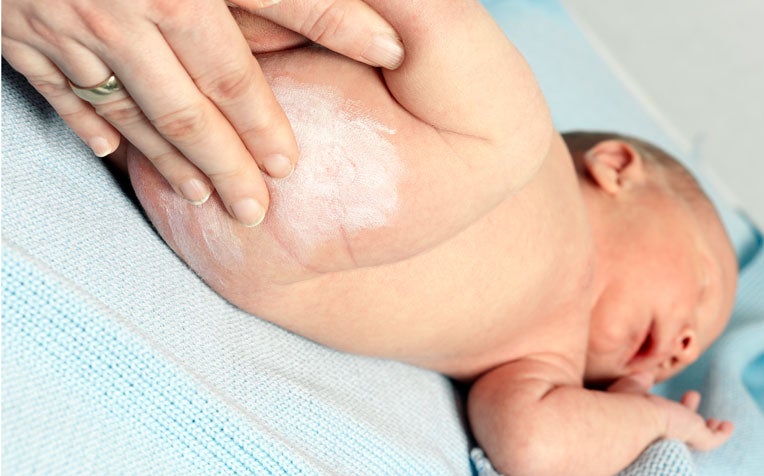
Baby skin conditions The skin of newborn babies may be flawless, but it is also sensitive and susceptible to rash, eczema, dermatitis and other skin conditions.
Skin conditions are not a simple cosmetic issue. “The skin is the largest organ of the body, and its functions are very important to the health of the other organ systems,” says Dr Mark Koh Jean Aan, Head and Consultant, Paediatric Dermatology Service, KK Women's and Children's Hospital (KKH), a member of the SingHealth group.
The skin is a crucial barrier that prevents excessive body fluid and mineral loss. It protects against infections and prevents absorption of toxic substances. It also helps regulate body heat.
Baby skin conditions can be caused by a variety of factors such as heat, cold, fungus, bacteria, drooling, allergies or prolonged contact with a wet nappy. Fortunately, most baby skin conditions are short-lived and clear up on their own over time. In more severe cases, however, creams and ointments, topical steroids, and oral medication may be required to resolve the problem.
Common skin conditions in babies
Heat rash
Heat rash, also known as prickly heat or miliaria, is a type of rash that occurs in newborns because their sweat glands, not fully developed, are easily blocked. It is especially prevalent in hot, humid climates such as in Singapore.
“Instead of evaporating, perspiration remains trapped beneath the skin, causing inflammation and rash,” explains Dr Koh.
- Symptoms: Small, red to clear, pin-pointed bumps, usually over covered sites such as the back and buttocks.
-
Causes:
- Excessive perspiration due to hot weather
- Dressing a baby too warmly or thick swaddling
- Dressing baby in fabrics that don’t allow sweat to evaporate normally
- A high fever
- Heavy creams and ointments that block the sweat ducts
Nappy rash
Nappy rash, also known as diaper dermatitis, affects 35 per cent of babies at some point in their first year of life. Its incidence peaks at about 9-12 months of age.
- Symptoms: A red, scaly rash over the areas of the skin that are covered by diapers.
-
Causes:
- Prolonged contact with urine and stools
- Excessive moisture from prolonged use of diapers
- Friction from fabric or adhesive tapes
- Secondary infection from bacteria or fungus / yeast
Cradle cap
Cradle cap, also known as seborrhoeic dermatitis, usually presents within the first few weeks of life and can recur for up to 4-6 months.
“Cradle cap occurs due to an overgrowth of a normal skin fungus / yeast, secondary to stimulation from maternal hormones while the baby is still in the womb. However, in some babies, it may be an early sign of atopic dermatitis or atopic eczema,” says Dr Koh.
- Symptoms: Scaly, pink to red patches on the scalp. Sometimes, other areas of the body are also affected, e.g. the neck, armpits and groin. Areas can present with greasy skin covered with flaky white or yellow scales.
-
Causes:
- An abnormal production of oil in the oil glands and hair follicles
- Yeast / bacterial infection
Atopic eczema
Atopic eczema, also known as atopic dermatitis, is the most common skin condition affecting adults and children, including babies. It affects up to 20 per cent of school-aged children in Singapore and for most patients, symptoms begin during the first year of life.
“Most children with eczema improve as they get older. However, the condition can recur after months or even years. With good control, many patients with eczema can lead healthy, active lives,” says Dr Koh.
- Symptoms: Patches of red, itchy, rough and dry skin, typically on a baby's cheeks and at the joints of the arms and legs.
-
Causes: The exact cause of atopic eczema is unknown. Atopic eczema is an immune reaction and has a genetic basis, being found to run in families. Contributory factors which can act as triggers or worsen the condition include:
- Environmental factors such as high temperatures, house dust mites, viral infections, vaccinations
- Allergens such as soaps, creams, detergents
Read on for treatment options for these common baby skin conditions.
Ref: S13













 Get it on Google Play
Get it on Google Play